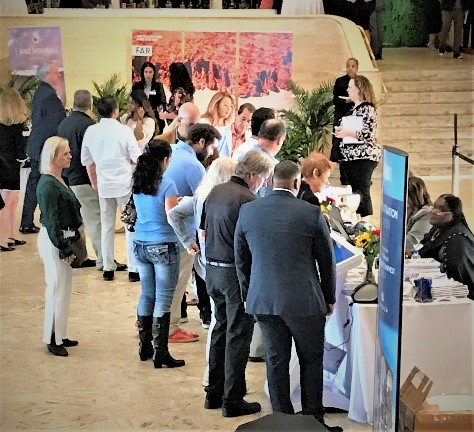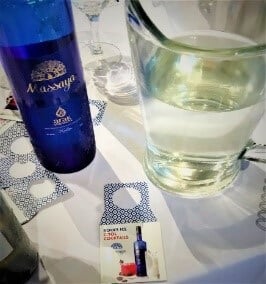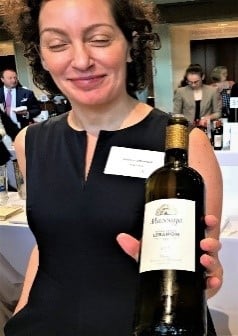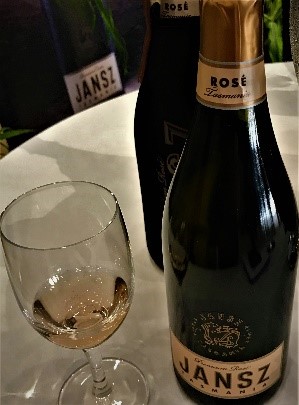
Hundreds of Wines Showcased at Lincoln Center
Winebow named the event the Vintners’ Harvest, but it really was an opportunity for wine makers in the Winebow portfolio to audition their collections at the David H. Koch Theater, Lincoln Center, a venue noted for showcasing stars. This year, buyers, sellers, journalists, educators, and other wine trade professionals had the opportunity to taste 500 world-class wines and spirits from over 200 of the world’s finest estates.
For over 30 years, Winebow has presented its international portfolio of fine wines and spirits that, according to Dean Ferrell, President and CEO of Winebow, “…focus on quality, knowledge and outstanding customer service.”
It is not easy for a winemaker to get accepted into the Winebow collection as the standards can be daunting (certainly tougher than getting into an ivy league college). The wines/spirits competing for the attention of the Winebow executives must be, “…authentic and interesting, and…express their distinct regions.” The mission of the company is to be, “…the most sought-after national importer and distributor of fine wines and spirits from around the world.”
Winebow was noted as the US importer of the year 2019 by Wine & Spirits magazine. The editors were so impressed with the selected wines – they claimed that, when they are faced with wines they do not recognize, they check the back of the bottle for trusted importers and select the wine based on the tastes and interests of the company. For 2019, many of the Winebow selections were among the Top 100 Wineries, Top 100 Wines and Best Buys of 2019.
Among my favorites (curated)
Massaya (twilight) & Co. Beqaa Valley & Mount Lebanon, Lebanon
Beqaa Valley is the base for modern Lebanese wines. The oldest winery (1857) was settled by the Jesuit Christians of Taanayel from vines carried from France via the colonies in Algeria. At this time, the country was controlled by the Ottoman Empire and the Sharia law condemned production or consumption of wine except for religious purposes.
Thanks to the French invasion after WW1 (under the League of Nations’ French Mandate for Syria and Lebanon), the wines of the region became important and the Beqaa Valley wine production began to be respected.
- Arak El Massaya 100 pf. Obeidi. Made from white Obeidi grapes (native Lebanese variety) and green aniseed; triple distilled in vine wood fired pot stills; maturated in old clay jars for an average of 2 years.
Massaya was started by Tanail Property and French oenophiles Dominique Hebran, Hubert de Bouard de Laforest and Daniel Brunier in Lebanon (1998) in cooperation with Sami and Ramzi Ghosn. Using organic techniques, the Ghosn’s were making wines on 123 acres from vines planted mainly in the northeast Beqaa Valley with limestone clay soil. The mountains protecting the Bekaa Valley from the influences of the Mediterranean Sea and desert make it a perfect area for viticulture. It is also protected from snow and heavy rain and is frost free with long summers and wet winters.
The grapes are harvested by hand in September, mechanically destemmed and gently crushed in a press to obtain the best Obeidi juice. The wine is then poured into traditional Moorish lid copper stills and heated by gentle fires of vine wood. As the vapors rise, they are carried through copper pipes into the cooling device where the alcohol condenses.
After 8 hours the process is repeated to remove impurities and leave the heart of the alcohol, the Coeur de chauffe. The third distillation (24 hours) gives the arak its purity and distinction. The third distillation is combined with the maceration of the best green organic aniseed from the village of Hineh on the Syrian slopes of Mount Hermon.
The non-aged arak is collected in traditional clay amphorae made by the potters in the Mount Lebanon village of Beit Chebab. These are just porous enough to absorb some of the liquid and allow it to breathe. During the resting period, lasting many months, the clay lends a faint golden clarity to the matured spirit that will carry the name El Massaya Arak.
Notes.
Clear to the eye, almost as transparent as fresh clean water. The nose finds lemons and grapefruit, light hints of licorice, but more like dried cumin and fennel seed; the palate detects fruit that is light and delicious offering a full-mouth feel.
Pair with Roasted leg of lamb, and Mediterranean mezze (olives, spices, meat, cheese) or serve as an aperitif. Drink very cold (may be diluted with water). Serve with ice cubes or crushed ice.
2. Massaya Rose 2019. Grape Variety – 100 percent Cinsault. Soil – chalky clay. Vine age – average 30 years.
Grown on the hillsides of the Beqaa Valley at an altitude of 900-1200 meters above sea level. Grapes are hand-picked and conveyed to crates. Direct pressing with a pneumatic press, static settling and fermentation in stainless steel vats. Bottling – 8 months.
Notes.
A strawberry pink to the eve, and red fresh berry fruit aromas are muted thanks to subtle spiciness that titillates the nose. The palate is rewarded with fresh fruitiness. Enjoy within 2 years of release. Pair with beef, lamb, chicken and spicy food.
3. Vilinka Cellars. Zilavka 2017. Mostar, Bosnia & Herzegovina.
Zilavka (Zilav means – tough), is a light skinned grape variety planted in the southern part of Bosnia-Herzegovina and Macedonia. The vineyards are located between the Adriatic coast and the city of Mostar (the largest city in Herzegovina) and the center for the area’s important wines. The grape produces wines that are fresh and with mild acidity. May be oak aged as a “barrique” vintage, presenting a full-bodied and earthy wine with nutty facets.
The vineyard was started as a venue for weddings. The founder is self-taught, learning viticulture and oenology from books. He planted his vines on a plateau 400m above sea level, on white pebble soil. This is excellent soil for local grape varieties: Zilavka (white), and Blatina (red). Most production is sold locally.
Notes.
Pale yellow straw to the eye. The nose finds hints of grass at the base, with apples, pears, kiwi, and nuts. The palate discovers lots of fruit (think German Riesling), tempered with light acidity. A long sweet finish delivers memories of black raisins. Pair with fish, seafood, prosciutto, and asparagus salad.
4. Stobi Winery. Vranec 2016. Republic of North Macedonia.
Since the time of antiquity, Stobi has been the largest city in Macedonia. The vines were planted near ancient shrines, and the roots reach the layers of soil under the ancient buildings.
The winery is located in central Macedonia, in the Tikvesh region. The Mediterranean climate from the south meets with the continental climate from the north, creating an area that is remarkable for grape growing and wine production. The vines are constantly supplied with water and the north winds provide natural protection against disease. Vranec accounts for almost 50 percent of the total vineyards planted with red grapes. The capacity of the winery is 4.5 million liters of which 1.2 million liters are used for fermentation.
Vranec (means strong black) is a black-skinned variety native to mountainous Montenegro that produces dense, deeply-colored red wines with flavors and aromas ranging from sour cherry, blackberry and blackcurrant to chocolate, mint and vanilla. It accounts for over 50 percent of all vineyards in Montenegro and an important variety for the economy.
The grape is vigorous and high yielding but sensitive to frost and botrytis. Berries are high in sugar which makes for wines that are relatively high in alcohol with a pleasant bitterness on the finish. It delivers high tannins and good levels of acidity. With oak ageing it picks up the vanilla and spice characteristics. Research suggests it has been planted since the middle ages.
Notes.
Dark ruby red trending to pink – rewards the eye. The nose recognizes cherry and strawberry with hints of red candy tempered by a suggestion of pepper – the light acidity and pleasant tannins, lead to a full-bodied cherry/berry rich finish. Pair with roast pork, prosciutto, venison, fatty cheese, lamb or veal.
5. Jansz Tasmania, Australia. Premium Rose Cuvee NV. 78 percent Pinot Noir, 22 percent Chardonnay.
Tasmania is a large island off the coast of Victoria and one of the world’s most remote wine regions. The Tasmania climate is similar to the French wine region of Champagne and Jansz’s first sparkling wine was produced using traditional Methode which is currently termed, “Methode Tasmanoise.”
Jansz is derived from the name of the Dutch explorer Abel Janszoon Tasman who discovered the island in 1642. The winery was established in 1975 and originally named Heemskerk, after the Tasman ship. In 1986, Louis Roederer partnered with Heemskerk Wines to produce Tasmania’s first premium vintage sparkling wine. In 1997, the Hill-Smith family purchased the vineyard, developing Jansz Tasmania, producing one of the most highly regarded sparkling wines in Australia.
Blending options are preserved by keeping batches separate during winemaking. Secondary fermentation in the bottle; aged on yeast lees. Perfect balance is reached in approximately 2 years.
Notes.
Vibrant pink to the eye with small bubbles. The nose finds roses and strawberries and the palate discovers creaminess in the peaches; the strawberries return to deliver a long fruity finish. Enjoy as an aperitif, or with salty snacks during Aperitivo. It also pairs well with raw oysters.
The Vintners’ Harvest


Arak El Massaya

Massaya Rose 2019

Vilinka Cellars. Zilavka 2017

Stobi, Vranec 2016

Jansz Tasmania, Australia. Premium Rose Cuvee NV

Many hundreds of wine trade professionals spent the day at Lincoln Center, exploring the Winebow star wines and spirits.
© Dr. Elinor Garely. This copyright article, including photos, may not be reproduced without written permission from the author.
